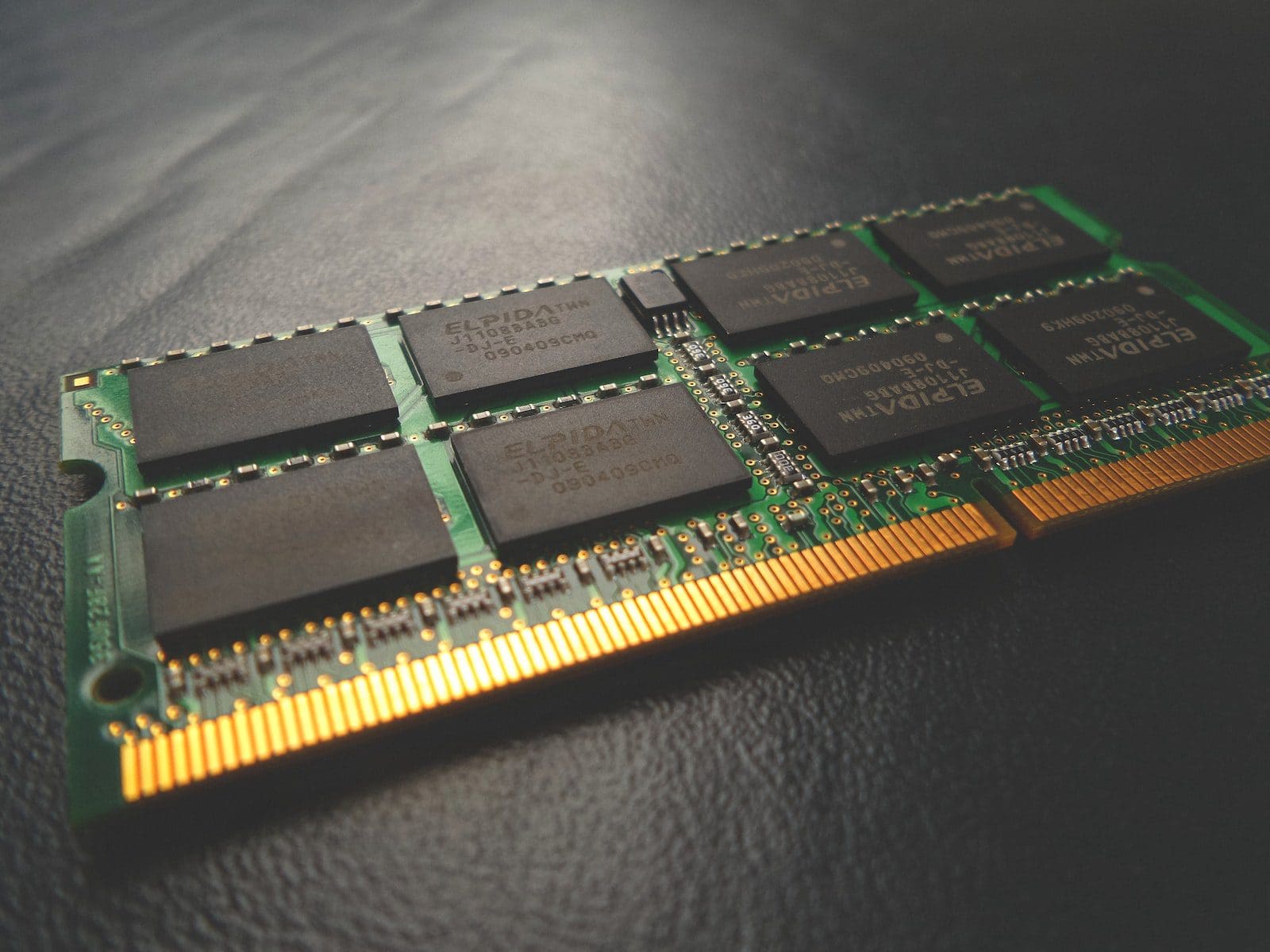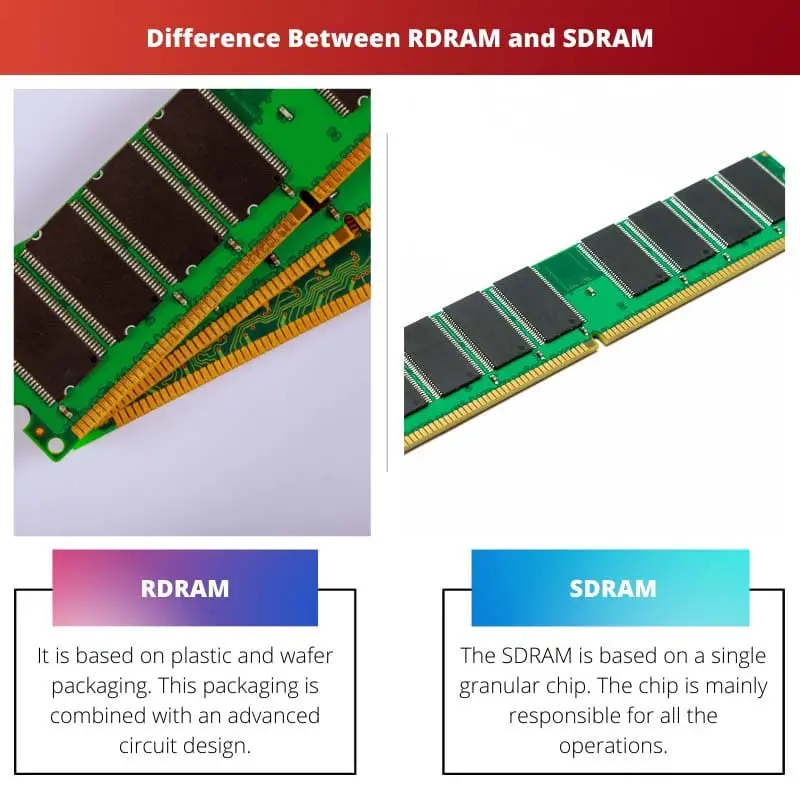All computing devices have two types of Random Access Memory – static and dynamic. RDRAM and SDRAM are the two types of dynamic RAM. These are used to store the instructions used for the processing of the device.
Key Takeaways
- RDRAM is a type of synchronous dynamic RAM with a high-speed, proprietary bus, while SDRAM uses a standard bus.
- RDRAM has higher latency and is more expensive than SDRAM.
- SDRAM is more widely used due to its compatibility with various systems and lower cost.
RDRAM vs SDRAM
The difference between RDRAM and SDRAM is that the RDRAM makes use of multiple chips for storage with fewer pins. On the other hand, the SDRAM has a single memory space with fewer instructions for the microprocessor.

RDRAM stands for Rambus dynamic random access memory. Being mentioned in its name itself, it acts as a dynamic storage space for a user’s data. This method of data storage became very popular because of its unique approach.
It helps accelerate the processing speed of a desktop or pc.
SDRAM stands for Synchronous dynamic random access memory. It runs on a device in close association with a data bus. It is widely used in different types of computers and has gained massive popularity since its release.
It responds to user inputs according to a clock schedule.
Comparison Table
| Parameters or comparison | RDRAM | SDRAM |
|---|---|---|
| Overall design concept | It is based on plastic and wafer packaging. This packaging is combined with an advanced circuit design. | The SDRAM is based on a single granular chip. The chip is mainly responsible for all the operations. |
| Bits and interface | It has around 64 bits in its interface along with an external interface. | The general bit count lies between 16-32 along with an external interface. |
| Clock system | The time slot is supplied to each channel through the system bus. It is passed on individually to each subpart. | The clock system works by increasing the number of instructions. The task gets completed bit by bit. |
| Loop mechanism | A Delay Locked Loop is used to establish a timely connection according to the clock schedule. | The SDRAM may work by using the Phase Locked Loop instead of DLL. The latter can also be found. |
| Uses and applications | RDRAM is used in graphics and gaming systems, video disk players, and multimedia personal computers. | It is widely used in different types of computer systems. It is employed when high processing speed is required. |
What is RDRAM?
The Rambus dynamic random access memory is designed to provide efficient processing. The input is provided in the form of instructions that are followed step by step.
The RDRAM increases the number of chips to deploy the work equally. This helps in increasing the processing speed and minimizing operation costs.
The advancement in computer technology has decreased the size of chips in this dynamic memory. The main advantage of this memory over SDRAM is the increased data size.
The 64-it processor works at a faster pace as compared to the conventional 16-bit sizes. It works on a single bus that is byte-wide.
This serves as a justification for the reduced costs associated with this dynamic storage. It is the first choice of professionals when a high bandwidth is required.
Some of these systems include broadband networks, image and data encoding, graphics, and HDTV systems. It is important to note that the applications are diversified and unlimited.
Dynamic RAM is marketed by a company of the same name. It has been gaining increasing popularity since the day it was introduced.
Different upgraded versions with modified pin counts have been introduced for specific requirements. The bit size is also increased to provide space for more data files.

What is SDRAM?
The synchronous random access memory follows a synchronized mechanism to provide optimized processing. The most well-known feature is the similar clock schedule for all the data that is transmitted.
The transfer of data takes place with one piece of data moving at a time. This is why it is also called single granular data storage.
The SDRAM has now been introduced in more than three variants. Each variant has an enhanced microprocessor speed and overall functioning.
The second-generation variant was one of the most revolutionary updates, with almost double the data speed. It has two notches that work on a power range of 2-5 volts.
The prefetch time of the versions ranges from 1 nanosecond to 3 nanoseconds which is quite remarkable. The memory has a well-developed circuit with chips located on it.
It functions with the help of different buses for the address and other aspects of data. Dynamic memory is aimed at saving the time taken by the CPU for processing data.
This is done by optimizing the time for each keyword. The data is transmitted at the exact speculated time, and the processor does not have to wait for the next command.
The SDRAM always works by increasing the count of instructions that are followed while the data is being processed. One may speculate that more instructions would mean more time. But what happens is exactly the opposite and is desirable.

Main Differences Between RDRAM and SDRAM
- The main difference that occurs between the two is the number of memory controllers. While SDRAM has only one memory controller, rdram has multiple controllers.
- The RDRAM is used for more diverse purposes as compared to the SDRAM.
- The overall performance of the RDRAM is better as compared to the SDRAM. This is due to the increased number of memory circuits.
- The modulus of RDRAM cannot be used individually as compared to SDRAM, where the same can be done.
- The heat produced by the RDRAM is more as compared to the energy liberated by the SDRAM.


The detailed explanation of RDRAM and SDRAM provides expert-level insight into the different aspects of these types of dynamic RAM.
I found the discussion about the high processing speed and data size of RDRAM very enlightening.
Absolutely. The comparison table was particularly helpful in understanding the differences between RDRAM and SDRAM.
The article’s detailed description and comparison of RDRAM and SDRAM have significantly broadened my knowledge of different RAM types.
The focus on RDRAM’s latency and cost compared to SDRAM was particularly noteworthy in the article.
The comparison of RDRAM and SDRAM in terms of clock systems and applications has enhanced my understanding of different RAM types.
I found the detailed discussion about the design concepts of RDRAM and SDRAM very valuable and informative.
The analysis of the clock systems and loop mechanisms in RDRAM and SDRAM was crucial in differentiating their functionalities.
The focus on the clock system and loop mechanism in RDRAM and SDRAM has expanded my understanding of how these dynamic RAM types operate.
I appreciate the detailed comparison of the clock systems between RDRAM and SDRAM. It really sheds light on their operational differences.
The applications and uses of RDRAM and SDRAM across various systems were explained with great clarity.
The in-depth analysis and comprehensive details about RDRAM and SDRAM provide valuable knowledge for computer enthusiasts and professionals alike.
The detailed explanation of the clock system and loop mechanism in RDRAM and SDRAM, along with the comparison table, has expanded my knowledge of these dynamic RAM types.
The discussion on the clock systems and loop mechanisms was insightful and added great value to the article.
The comprehensive comparison of RDRAM and SDRAM in terms of their clock systems and loop mechanisms provided a deep understanding of their functionalities.
The detailed explanation of RDRAM and SDRAM’s uses and applications, along with the comparison table, has been incredibly informative and helpful.
The detailed discussion on the clock system and loop mechanism has significantly contributed to my understanding of RDRAM and SDRAM.
The comprehensive details about RDRAM and SDRAM’s uses and applications, including the comparison table, were extremely informative and insightful.
The detailed description of RDRAM and SDRAM’s overall design concept and clock systems was very enlightening.
The explanation of the clock system and loop mechanism in RDRAM and SDRAM provided a clear understanding of their functionality.
A thorough and well-organized comparison of RDRAM and SDRAM. The detailed analysis of the design concept, bits and interface, clock system, loop mechanism, and uses and applications was especially informative.
Couldn’t agree more. The article provided a comprehensive understanding of RDRAM and SDRAM and their applications in different systems.
The detailed explanation of RDRAM and SDRAM’s uses and applications in various systems provided a comprehensive understanding of their significance in computer technology.
The discussion on the clock system and loop mechanism in RDRAM and SDRAM was highly informative and adds great value to the article.